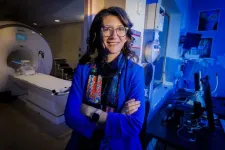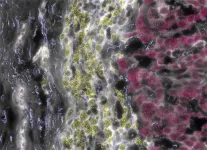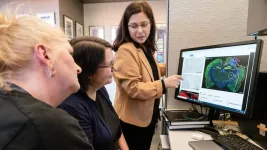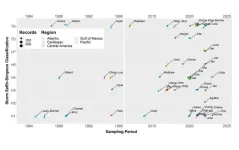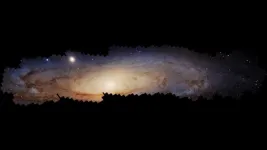(Press-News.org) ARLINGTON, Va.—A favorite childhood memory for Dr. Sandra Chapman was visiting the USS Arizona Memorial in Pearl Harbor with her father. They hung out at the memorial so often that they memorized lines to the movie playing prior to the boat ride to the memorial.
So it’s appropriate that Chapman — a program officer in the Office of Naval Research’s (ONR) Warfighter Performance Department — is passionate about her involvement in the development of an innovative technology recently applied to efforts to preserve the area around the USS Arizona Memorial.
Developed in partnership with Naval Sea Systems Command (NAVSEA) and Coda Octopus, the system is the Divers Augmented Vision Display (DAVD), which enables divers to better operate in inhospitable underwater environments.
“Through real-time information sharing, high-resolution imagery and an augmented-reality display, DAVD allows Navy divers to operate more effectively in dark, low-visibility environments,” said Chapman. “This increases their productivity, improves communications, keeps them safe and turns on the lights underwater, so to speak.”
Navy diving missions include deep ocean salvage of vessels and aircraft, underwater rescues, explosive ordnance disposal, ship hull maintenance and recovery of sunken equipment. This often involves working in pitch-black, dangerous conditions littered with hazards such as pier pilings, rock and jagged metal.
Designed to address these challenges, DAVD’s most prominent feature is a heads-up display resembling virtual-reality glasses, which can be adapted to any Navy dive helmet. Other components include specialized augmented-reality software (which allows the Coda Octopus 3D sonar or virtual images to be overlaid on a physical landscape), laptops, cables, cameras and lighting.
While using DAVD, a diver is tethered to a ship or floating platform by cables transmitting vital information between the diver and surface team — including rate of ascent and descent, time elapsed, current and maximum depth, and remaining levels of breathing gas.
DAVD can take sonar imagery gathered before and during a dive and use it to create a detailed 3D model of the dive site. In addition, divers are able to receive videos, technical manuals, images, messages and other data to help them navigate underwater and maintain smooth communications with the surface.
“As a diver, I’ll say DAVD is a game-changer,” said Lt. Matthew Coleman, a NAVSEA assistant for salvage. “It gives us an extremely detailed view of the bottom — with much more accuracy than what we used previously — and is an excellent tool for completing any mission, in all working conditions.”
DAVD’s roots stretch back to 2019, when ONR sponsored its development to answer a need voiced by NAVSEA to improve diver visibility underwater. It eventually was moved to ONR’s Future Naval Capabilities program, which is designed to complete development of mature technologies and transition them into naval programs of record.
In the subsequent years, multiple versions of DAVD were introduced into the fleet for testing, demonstration and transition, each with new improvements and upgrades. The latest iteration entered service in 2023.
Approximately 15 DAVD systems are currently being used by nine naval commands — and have played important roles in both naval and non-naval operations. For example, in the aftermath of the 2023 wildfires in Maui, Hawaii, Navy divers used DAVD to locate 26 boats that had sunk along a marina during the disaster.
Navy and Coda Octopus engineers also employed the DAVD 3D sonar systems to assist in salvage efforts after the March 2024 collapse of Baltimore’s Francis Scott Key Bridge. And DAVD was instrumental in efforts to map the murky waters surrounding the sunken USS Arizona. The purpose was to help U.S. Pacific Fleet and the National Park Service inspect the condition of submerged, severely degraded construction moorings used to build the memorial in the 1950s.
In the future, Chapman and McMurtrie envision potential upgrades to DAVD that could include GPS for georeferencing (relating a digital map or image to geographic coordinates), physiological monitoring such as an eye-tracking device, or enabling DAVD to work without cables connecting to the surface.
“As we get regular feedback from divers, we want to continuously upgrade and improve DAVD to ensure it stays effective and relevant,” said Paul McMurtrie, NAVSEA diving systems program manager. “Similar to how your iPhone is always getting upgrades.”
END
‘Turn on the lights’: DAVD display helps navy divers navigate undersea conditions
2025-01-17
ELSE PRESS RELEASES FROM THIS DATE:
MSU researcher’s breakthrough model sheds light on solar storms and space weather
2025-01-17
Images
EAST LANSING, Mich. – Our sun is essentially a searing hot sphere of gas. Its mix of primarily hydrogen and helium can reach temperatures between 10,000 and 3.6 million degrees Fahrenheit on its surface and its atmosphere’s outermost layer. Because of that heat, the blazing orb constantly oozes a stream of plasma, made up of charged subatomic particles — mainly protons and electrons. The sun’s gravity can’t contain them because they hold so much energy as heat, so they drift away into space as solar wind. Understanding how charged particles ...
Nebraska psychology professor recognized with Presidential Early Career Award
2025-01-17
Maital Neta, professor of psychology at the University of Nebraska–Lincoln, has received the Presidential Early Career Award for Scientists and Engineers, the highest honor bestowed by the U.S. government on outstanding scientists and engineers early in their careers.
Neta, Carl A. Happold Professor of Psychology, directs the Cognitive and Affective Neuroscience Lab and is resident faculty of the Center for Brain, Biology and Behavior.
Neta said she was “very grateful” for the honor, announced ...
New data shows how ‘rage giving’ boosted immigrant-serving nonprofits during the first Trump Administration
2025-01-17
As Donald Trump prepares to take office for a second term as President, research led by the University of California, Santa Cruz is demonstrating the important role nonprofits played during Trump’s first term as a counterforce that channeled public resistance to anti-immigrant policies.
The new study, published in the journal International Migration Review, shows how nonprofits that provide legal services for immigrants ended up receiving increases in public contributions in the wake of Trump's attacks on immigrants.
Previously, there had been many reported examples of this backlash effect, sometimes called ...
Unique characteristics of a rare liver cancer identified as clinical trial of new treatment begins
2025-01-17
Like many rare diseases, fibrolamellar hepatocellular carcinoma (FLC) mounts a ferocious attack against an unlucky few—in this case, children, adolescents, and young adults. Because its symptoms can vary from person to person, it’s often missed or misdiagnosed until it has metastasized and becomes lethal. Moreover, drug therapies for common liver cancers are not just useless for FLC patients but actually harmful.
But new insights about the disease, coupled with a just-launched clinical trial of a promising drug treatment, could significantly improve health outcomes. Researchers in Rockefeller University’s Laboratory of Cellular Biophysics, headed by Sanford ...
From lab to field: CABBI pipeline delivers oil-rich sorghum
2025-01-17
Researchers at the Center for Advanced Bioenergy and Bioproducts Innovation (CABBI) have developed a new sorghum variant that can outperform soybeans in oil production, with great potential as a clean source of renewable fuel.
Scientists have long worked to create new sustainable sources of vegetable oils, known as triacylglycerols (TAG), to meet the growing demand for renewable fuels like sustainable aviation fuel (SAF) and renewable diesel.
Currently, oil palm and oilseeds such as soybeans provide most TAG for renewable ...
Stem cell therapy jumpstarts brain recovery after stroke
2025-01-17
SAN FRANCISCO—Every 40 seconds, someone in the United States has a stroke. For survivors of the most common type of stroke, called an ischemic stroke, only about 5 percent fully recover. Most others suffer from long-term problems, including weakness, chronic pain, or epilepsy.
Now, scientists at Gladstone Institutes and the regenerative medicine company SanBio have shown that a cell therapy derived from stem cells can restore normal patterns of brain activity after a stroke. While most stroke treatments must be administered in the immediate hours ...
Polymer editing can upcycle waste into higher-performance plastics
2025-01-17
Polymer editing can upcycle waste into higher-performance plastics
By editing the polymers of discarded plastics, chemists at the Department of Energy’s Oak Ridge National Laboratory have found a way to generate new macromolecules with more valuable properties than those of the starting material. Upcycling may help remedy the roughly 450 million tons of plastic discarded worldwide annually, of which only 9% gets recycled; the rest is incinerated or winds up in landfills, oceans or elsewhere.
ORNL’s ...
Research on past hurricanes aims to reduce future risk
2025-01-17
Tropical storms like hurricanes are not only terrifying, but also incredibly costly for coastal regions across the United States, Mexico, Central America and the Caribbean. Beyond the immediate devastation, these storms contribute to significant economic losses and human displacement. In 2023 alone, climate migration linked to such events saw 2.5 million individuals attempt to cross the U.S. southern land border.
New research led by The University of Texas at Arlington emphasizes that studying ...
UT Health San Antonio, UTSA researchers receive prestigious 2025 Hill Prizes for medicine and technology
2025-01-17
SAN ANTONIO, Jan. 17, 2025 – On the eve of a historic merger between The University of Texas Health Science Center at San Antonio and The University of Texas at San Antonio, researchers from the two institutions have been honored with highly prestigious 2025 Hill Prizes, in medicine and technology.
The prizes are awarded by the Texas Academy of Medicine, Engineering, Science and Technology (TAMEST), and Lyda Hill Philanthropies, which fund the awards to “propel high-risk, high-reward ideas and innovations that demonstrate very significant potential for real-world impact and can lead ...
Panorama of our nearest galactic neighbor unveils hundreds of millions of stars
2025-01-17
In the decades following the launch of NASA's Hubble Space Telescope, astronomers have tallied over 1 trillion galaxies in the universe. But only one galaxy stands out as the most important nearby stellar island to our Milky Way — the Andromeda Galaxy. It can be seen with the naked eye on clear autumn nights as a faint oval object roughly the size of the moon.
A century ago, astronomer Edwin Hubble first established that this so-called "spiral nebula" was approximately 2.5 million light years away from our own Milky Way galaxy.
Now, the space telescope named ...

